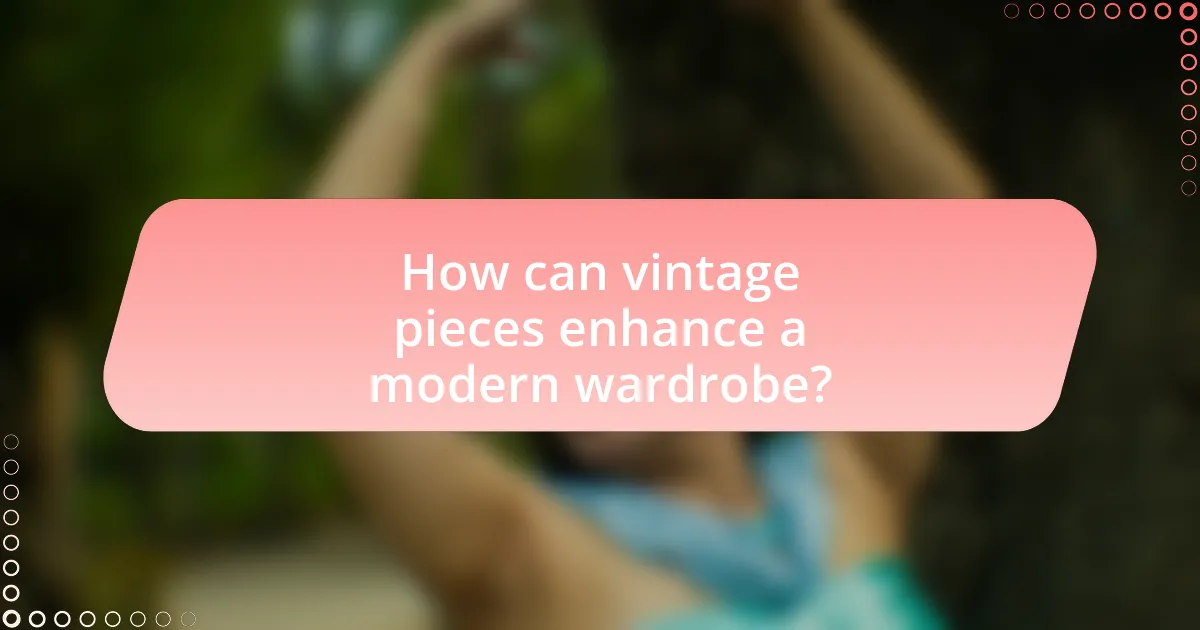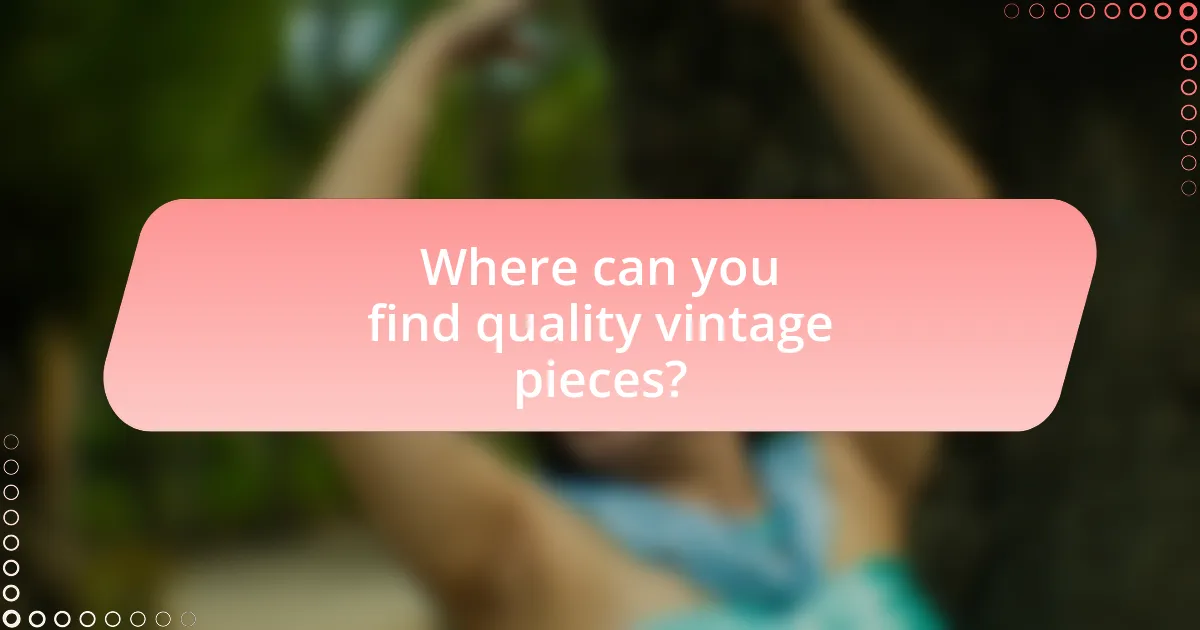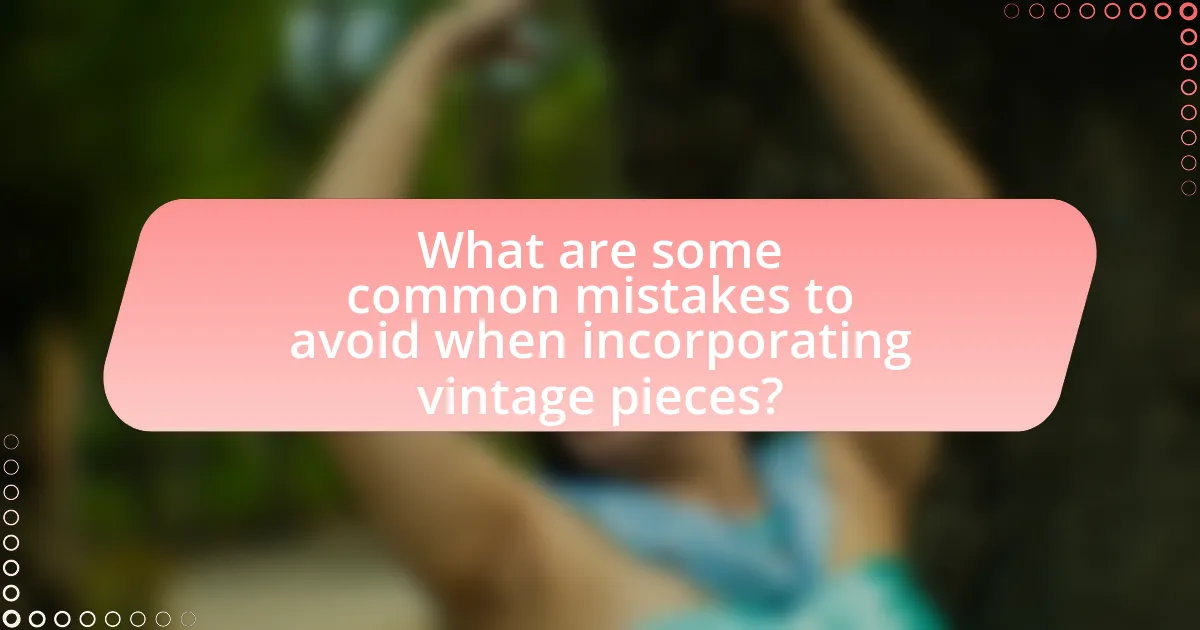The article focuses on how to effectively incorporate vintage pieces into modern wardrobes, highlighting the unique character and individuality that vintage items can bring to contemporary fashion. It defines vintage pieces as items at least 20 years old, emphasizing their distinctive designs and craftsmanship compared to modern clothing. The article discusses the benefits of mixing vintage and modern styles, including sustainability and personal expression, while also addressing challenges such as sizing inconsistencies and sourcing complementary items. Additionally, it provides practical tips for styling vintage pieces, maintaining their quality, and ensuring authenticity, making it a comprehensive guide for those looking to enhance their wardrobe with vintage fashion.

How can vintage pieces enhance a modern wardrobe?
Vintage pieces can enhance a modern wardrobe by adding unique character and individuality to outfits. These items often feature distinctive designs, high-quality materials, and craftsmanship that are less common in contemporary fashion, allowing wearers to stand out. For example, vintage clothing from the 1960s or 1970s often incorporates bold patterns and colors that can serve as statement pieces in a modern ensemble. Additionally, incorporating vintage accessories, such as handbags or jewelry, can elevate a simple outfit, providing a touch of nostalgia and style that resonates with current trends. The blend of vintage and modern elements creates a visually interesting aesthetic that reflects personal style while promoting sustainability through the reuse of clothing.
What defines a vintage piece in fashion?
A vintage piece in fashion is defined as an item that is at least 20 years old, reflecting the style and trends of a specific past era. This classification is supported by the fashion industry, which often considers garments from the 1920s to the 1990s as vintage, emphasizing their historical significance and unique design elements. Vintage pieces are sought after for their quality craftsmanship, distinctive aesthetics, and the nostalgia they evoke, making them valuable additions to modern wardrobes.
How do vintage pieces differ from contemporary fashion items?
Vintage pieces differ from contemporary fashion items primarily in their design, materials, and cultural significance. Vintage fashion typically reflects the styles, trends, and craftsmanship of a specific historical period, often showcasing unique silhouettes and high-quality fabrics that are less common in modern mass-produced clothing. For example, garments from the 1960s may feature bold patterns and tailored fits that contrast with the more casual and minimalist aesthetics prevalent in contemporary fashion. Additionally, vintage items often carry a sense of nostalgia and individuality, appealing to consumers seeking distinctiveness in their wardrobe, whereas contemporary items tend to prioritize current trends and accessibility. This distinction highlights the enduring value of vintage fashion as a representation of past eras and craftsmanship.
What are the characteristics of popular vintage styles?
Popular vintage styles are characterized by distinct design elements, materials, and cultural influences from specific historical periods. For example, the 1920s flapper style features dropped waistlines, fringe, and beading, reflecting the era’s liberation and jazz culture. The 1950s rockabilly style is marked by high-waisted skirts, fitted bodices, and bold prints, showcasing post-war optimism and youth culture. Additionally, the 1970s bohemian style includes flowing fabrics, ethnic prints, and a relaxed silhouette, emphasizing individuality and counterculture movements. Each of these styles not only represents fashion trends but also encapsulates the social and cultural dynamics of their respective times.
Why should you incorporate vintage pieces into your wardrobe?
Incorporating vintage pieces into your wardrobe enhances individuality and sustainability. Vintage clothing often features unique designs and high-quality materials that are not commonly found in contemporary fashion, allowing for a distinctive personal style. Additionally, choosing vintage supports sustainable fashion practices by reducing waste and promoting the reuse of garments, which is crucial given that the fashion industry contributes significantly to environmental degradation. According to a report by the Ellen MacArthur Foundation, the fashion industry is responsible for 10% of global carbon emissions, highlighting the importance of sustainable choices like vintage clothing.
What are the benefits of mixing vintage and modern styles?
Mixing vintage and modern styles enhances aesthetic appeal and creates unique personal expression. This combination allows individuals to showcase their personality by blending timeless pieces with contemporary designs, resulting in a distinctive look that stands out. Additionally, incorporating vintage items often promotes sustainability by encouraging the reuse of materials, which reduces waste and environmental impact. According to a study by the Ellen MacArthur Foundation, the fashion industry is responsible for significant waste, and embracing vintage can help mitigate this issue. Furthermore, mixing styles can also lead to cost savings, as vintage items are often more affordable than new designer pieces, allowing for a more budget-friendly approach to fashion.
How can vintage pieces reflect personal style and individuality?
Vintage pieces reflect personal style and individuality by offering unique designs and historical context that differentiate them from contemporary fashion. Each vintage item carries a story, often showcasing craftsmanship and aesthetics from a specific era, which allows individuals to express their tastes and preferences distinctively. For example, a 1970s bohemian dress can convey a free-spirited personality, while a tailored 1950s suit may reflect a classic, sophisticated style. The rarity of vintage items also means that wearing them can create a sense of exclusivity, further enhancing personal identity. This connection to history and uniqueness enables individuals to curate wardrobes that are not only fashionable but also deeply personal.
What challenges might arise when incorporating vintage pieces?
Incorporating vintage pieces can present challenges such as sizing inconsistencies, potential damage, and difficulty in sourcing complementary items. Sizing inconsistencies arise because vintage clothing often follows different sizing standards than contemporary fashion, making it hard to find a proper fit. Additionally, vintage items may have wear and tear, requiring repairs or alterations, which can complicate their integration into a modern wardrobe. Lastly, sourcing complementary modern pieces that harmonize with vintage styles can be challenging, as the aesthetic and fabric choices may differ significantly from current trends.
How can you overcome sizing and fit issues with vintage clothing?
To overcome sizing and fit issues with vintage clothing, one can utilize tailoring services to adjust garments for a better fit. Tailoring allows for alterations such as taking in or letting out seams, shortening or lengthening hems, and adjusting sleeve lengths, which can transform a vintage piece to fit modern body shapes. According to a study by the Fashion Institute of Technology, 70% of consumers prefer tailored clothing for improved fit, highlighting the importance of customization in achieving a satisfactory fit with vintage items.
What are the best practices for maintaining vintage items?
The best practices for maintaining vintage items include proper cleaning, controlled storage conditions, and regular inspections. Cleaning vintage items should be done with gentle, non-abrasive materials to avoid damage; for example, using a soft cloth and mild soap for fabrics or specialized cleaners for metals. Controlled storage conditions involve keeping items in a cool, dry place away from direct sunlight to prevent fading and deterioration, as high humidity can lead to mold growth. Regular inspections help identify any signs of wear or damage early, allowing for timely repairs. These practices are essential for preserving the integrity and longevity of vintage items, ensuring they remain in good condition for future enjoyment.
How can you effectively mix vintage and modern pieces?
To effectively mix vintage and modern pieces, focus on balancing the styles by selecting complementary colors and textures. For instance, pairing a vintage floral dress with a modern leather jacket creates a harmonious contrast that highlights both elements. Additionally, using accessories, such as a contemporary handbag with vintage jewelry, can seamlessly blend the two styles. This approach is supported by design principles that emphasize contrast and cohesion, allowing for a visually appealing outfit that respects both eras.
What are some tips for styling vintage pieces with contemporary outfits?
To effectively style vintage pieces with contemporary outfits, focus on balancing the old and new by selecting one or two vintage items and pairing them with modern staples. For instance, a vintage blazer can be worn over a simple white t-shirt and jeans, creating a chic contrast that highlights both styles. Additionally, accessorizing with contemporary items, such as minimalist jewelry or modern footwear, can help to ground the vintage piece in a current context. This approach not only showcases the uniqueness of the vintage item but also ensures that the overall look remains relevant and stylish.
How can accessories enhance the integration of vintage items?
Accessories can enhance the integration of vintage items by bridging the gap between old and new styles, creating a cohesive look. For instance, modern accessories like minimalist jewelry or contemporary bags can complement vintage clothing, allowing the vintage pieces to stand out while still feeling relevant. This approach is supported by fashion trends that emphasize mixing eras, as seen in runway shows where designers often pair vintage garments with modern accessories to create fresh, innovative outfits.
What color palettes work best when combining vintage and modern styles?
Color palettes that work best when combining vintage and modern styles typically include muted tones, earth tones, and pastel shades. These palettes create a harmonious balance between the nostalgic feel of vintage pieces and the sleekness of modern design. For instance, pairing soft blush pinks or sage greens with deeper hues like navy or burgundy can evoke a vintage charm while maintaining a contemporary edge. Additionally, incorporating neutral colors such as beige, gray, or white can help to ground the overall look, allowing vintage items to stand out without overwhelming the modern elements. This approach is supported by design principles that emphasize contrast and cohesion, ensuring that both styles complement rather than clash.

Where can you find quality vintage pieces?
Quality vintage pieces can be found at specialized vintage shops, thrift stores, estate sales, and online marketplaces such as Etsy and eBay. These venues often curate unique selections of clothing and accessories from various eras, ensuring authenticity and quality. For instance, vintage shops typically have knowledgeable staff who can verify the age and condition of items, while estate sales often feature high-quality pieces from previous owners. Online platforms like Etsy allow sellers to showcase their vintage collections, providing a wide range of options for buyers seeking specific styles or periods.
What are the best sources for vintage clothing?
The best sources for vintage clothing include thrift stores, estate sales, flea markets, and online platforms like Etsy and eBay. Thrift stores often have a rotating selection of unique items at affordable prices, while estate sales can provide high-quality vintage pieces directly from previous owners. Flea markets typically feature a variety of vendors, offering a wide range of vintage styles. Online platforms like Etsy and eBay allow for a broader search, connecting buyers with sellers worldwide, which increases the chances of finding rare and desirable vintage items.
How do thrift stores compare to online vintage shops?
Thrift stores offer a tactile, in-person shopping experience with immediate access to a diverse range of vintage items, while online vintage shops provide convenience and a broader selection that can be accessed from anywhere. Thrift stores often feature unique, one-of-a-kind pieces that may not be available online, allowing shoppers to discover hidden gems. In contrast, online vintage shops typically curate their collections, often providing detailed descriptions and images, which can enhance the shopping experience. According to a 2021 report by ThredUp, the resale market, including thrift stores and online platforms, is projected to reach $64 billion by 2024, indicating a growing interest in both avenues for vintage shopping.
What should you look for when shopping at vintage markets?
When shopping at vintage markets, you should look for unique, high-quality items that reflect your personal style and are in good condition. Unique pieces often include clothing, accessories, or home decor that cannot be found in contemporary stores, allowing for individual expression. High-quality items are typically made from durable materials and exhibit craftsmanship, which is essential for longevity. Additionally, checking for signs of wear, such as fraying or discoloration, ensures that the items are still functional and aesthetically pleasing. Vintage markets often feature items from specific eras, so understanding the characteristics of those periods can help in making informed choices.
How can you ensure the authenticity of vintage pieces?
To ensure the authenticity of vintage pieces, verify their provenance through documentation and expert appraisal. Provenance includes original receipts, tags, or certificates of authenticity that trace the item’s history. Expert appraisers can provide insights based on material, craftsmanship, and design elements characteristic of specific eras, such as the distinct stitching patterns or fabric types used in 1950s fashion. Additionally, researching the brand’s production methods and historical context can further confirm authenticity, as many reputable vintage brands have identifiable features that can be cross-referenced with known examples.
What signs indicate a genuine vintage item?
Genuine vintage items typically exhibit specific signs such as unique craftsmanship, distinctive labels, and signs of aging. Unique craftsmanship refers to the quality and techniques used in the item’s creation, often reflecting the era it was made in, such as hand-stitching or specific materials that were prevalent at the time. Distinctive labels can include brand tags or care labels that were used during a particular period, which can help date the item accurately. Signs of aging, such as patina, wear, or fading, indicate that the item has been used over time, further confirming its vintage status. Collectors often reference these characteristics to authenticate vintage pieces, as they align with historical production methods and materials.
How can you research the history of a vintage piece?
To research the history of a vintage piece, start by identifying its brand, model, and any distinguishing features. This information allows you to search for specific details in online databases, auction sites, and vintage fashion forums. Utilize resources such as books on fashion history, museum collections, and academic articles that focus on the era or style of the piece. For example, the “Fashion Institute of Technology” offers extensive archives and publications that can provide context and historical significance. Additionally, engaging with vintage communities on social media platforms can yield personal anecdotes and insights from collectors and enthusiasts, further enriching your understanding of the piece’s background.

What are some common mistakes to avoid when incorporating vintage pieces?
Common mistakes to avoid when incorporating vintage pieces include failing to consider scale and proportion, which can lead to an unbalanced look. For instance, pairing a large vintage dress with equally voluminous accessories can overwhelm the outfit. Additionally, neglecting to mix vintage with modern elements can create a dated appearance; blending styles helps maintain a contemporary feel. Another mistake is overlooking the condition of vintage items; damaged or worn pieces can detract from the overall aesthetic. Lastly, not understanding the historical context of vintage items may result in inappropriate styling choices, as certain pieces may carry specific cultural significance.
How can you avoid clashing styles when mixing vintage and modern clothing?
To avoid clashing styles when mixing vintage and modern clothing, focus on balancing silhouettes and color palettes. Selecting pieces that complement each other in terms of fit and hue ensures a cohesive look. For instance, pairing a fitted modern top with a flowing vintage skirt can create harmony, while sticking to a similar color scheme, such as earth tones or monochromatic shades, enhances visual unity. This approach is supported by fashion experts who emphasize the importance of cohesion in style combinations, as seen in various fashion guides and articles.
What are the pitfalls of overdoing vintage in an outfit?
Overdoing vintage in an outfit can lead to a dated or costume-like appearance. When an outfit is excessively vintage, it may lack modern relevance, making the wearer seem out of touch with current fashion trends. This can result in a visual overload, where the combination of multiple vintage pieces clashes rather than complements, detracting from the overall aesthetic. Additionally, wearing too many vintage items can obscure personal style, as the outfit may feel more like a tribute to a past era rather than a reflection of individual identity.
How can you maintain a balanced look with vintage and modern elements?
To maintain a balanced look with vintage and modern elements, combine one statement piece from each style to create harmony. For instance, pairing a vintage dress with contemporary accessories like a modern handbag or shoes can unify the two aesthetics. This approach leverages the contrast between the old and new, allowing each element to complement rather than compete with one another. Additionally, using a cohesive color palette that ties both styles together can enhance the overall look, ensuring that the vintage and modern pieces feel intentional and curated.
What practical tips can help you successfully incorporate vintage pieces?
To successfully incorporate vintage pieces, blend them with modern items to create a balanced look. For instance, pairing a vintage dress with contemporary accessories can modernize the outfit while retaining its unique charm. Additionally, consider the scale and proportion; oversized vintage items can be balanced with fitted modern pieces to avoid overwhelming the silhouette. Color coordination is also crucial; select vintage items that complement your existing wardrobe palette to ensure cohesion. Lastly, layering vintage pieces with modern staples can add depth and interest to your outfit, making the vintage elements stand out without clashing.
How can you start small when adding vintage items to your wardrobe?
To start small when adding vintage items to your wardrobe, begin by selecting a few key accessories, such as scarves, belts, or jewelry, that can enhance your existing outfits. Accessories are less intimidating and can easily blend with modern clothing, allowing for a gradual introduction of vintage style. Research indicates that incorporating small vintage pieces can elevate personal style without overwhelming the wearer, as noted in fashion studies highlighting the versatility of accessories in wardrobe integration.
What are some essential vintage pieces every wardrobe should have?
Essential vintage pieces every wardrobe should have include a classic denim jacket, a little black dress, high-waisted trousers, and vintage accessories like statement jewelry. The classic denim jacket, popularized in the 1950s, remains versatile and timeless, suitable for various outfits. The little black dress, introduced by Coco Chanel in the 1920s, is a staple for formal and casual occasions alike. High-waisted trousers, reminiscent of styles from the 1970s, offer a flattering silhouette and can be paired with modern tops. Vintage accessories, such as bold earrings or unique handbags, add character and individuality to any outfit, reflecting personal style while enhancing contemporary looks.


